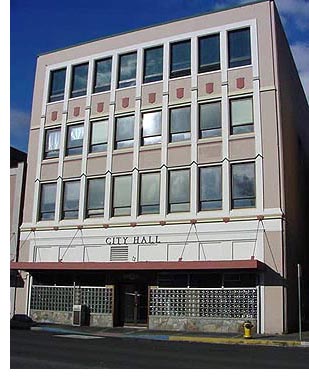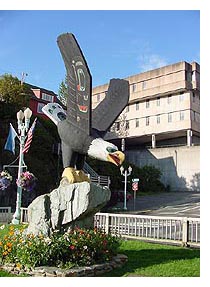 City Hall - Call It 'Stately' By June Allen April 17, 2002
One of my personal favorites is the incredibly elaborate cornice at the top of the '49er Bar building. Did the carpenter who accomplished that feat of his craft in 1925 stand across Tongass Avenue and admire his artistry when it was completed? Another is the totally authentic façade of the same-era New York Hotel on Stedman Street, tediously and artistically restored by Fred Oschner in the late '80's. Both examples show the levels of skills, pride and permanence of the spirit of Ketchikan over the century since its founding. Another personal favorite is Ketchikan's City Hall on Front Street. Today the street level facade of this 1925 structure has been remodeled and tinkered with over the years. The glass brick must have come sometime much later. Architectural glass brick, at least for mass production, became feasible only after experimentation in the 1920s and success in the early '30s. During those years of Prohibition (1920-1933), bottle makers faced bankruptcy! The vast numbers of beer bottles - America's favorite beverage - were no longer needed commercially. So bottle manufacturers worked to develop other glass products, including glass brick as a building material. Glass bricks took time to catch on, but catch on they did, as witness the façade of our Elks Club/Fireside building built in the mid-'40s. City Hall was built in 1925
by the private utility company Citizens Power & Light. At
that time, the street level floor contained sales rooms for electrical
appliances, and there were display windows facing Front Street,
showing off the long-legged electric ranges, shiny toasters,
maybe waffle irons and other necessities for the modern home.
General offices were also on that floor. The second floor housed
machine shops, supplies and equipment. The third floor had warehouse
and drafting space, plus the small town's telephone exchange
of about 1,000 lines. It wasn't long before the building became known as the KPU building. Much of the heavy sorts of utility operations moved to other city spaces. The Front Street building then became the heart of the city government. In a deal with the library folks, the library moved into City Hall, on the second floor where the council chambers are today. And over the years other changes to the building came about, including the addition of council chambers, and moving in the city police. The city police station was in the first room to the left when entering the rear door of the building - whenever it was that those changes came about. But in any event, at the advent of mid-century the town knew it was about to become home to Ketchikan Pulp Company - which meant a population boom, first of construction workers not only for the mill but for road-building to create new homesites north of town, then of mill workers, and workers for the support businesses for the mill and for logger operations in the woods. The population figures for the city jumped by almost 2,000 in the 20 years between the 1940 and 1960 census reports. And with people came all the new housing and all the businesses and with both the need for more telephone lines. So in July of 1951 Mayor George Beck, his signature attested by City Clerk Bertha McKay, signed Resolution No. 462, which authorized a contract for architectural services to add a fourth floor to City Hall. The next year both signed the resolution allowing the city to enter into a contract with O.M. Lien, dba Pioneer Cabinet Shop, to build that fourth floor for $95,808. When built, the fourth floor became the phone exchange for 225- numbers, and later for 247- numbers. During the 1952-54 years of
construction on the tunnel and the reinforced street around
the tunnel, KPU offered a hotline so that people could call
in and find out when the lengthy delays were scheduled for traffic
hoping to get from one side of town to the other. Oldtimers recall
long lines of cars waiting on Front Street, some drivers eating,
some At one time, when the city police offices were to the left of the rear entrance of City Hall, the tiny city jail was crowded into the room(s) just to the right. I don't know when the jail was moved out and into the federal building, which came to share facilities with offices of the new State of Alaska. I'd guess it was shortly after Statehood in 1959, and would love to hear from anyone who knows the date. I do know that the newly formed Tongass Historical Society moved into the space, opening when volunteer help was available. I toured that tiny space in 1964 or '65, admiring the small collection. When I came to town in 1964, the town was finally in recovery from the mid-1950's scandal in the police department, when both the police chief and his captain were convicted of offenses related to the city's widespread prostitution, graft and vice. After the cleanup and final closure of houses of prostitution the town was edgy and mistrustful. Immediate replacements in the police department's highest position were found unsatisfactory until the crusty and no-nonsense Hank Miller, a former Anchorage chief, was named Ketchikan's chief in 1957. He would serve until 1972 when an accident and ill health required his retirement. A room at the back of the small police department office, so small it may have been a storeroom or closet, was the chief's office. One of the first things I did when I came to Ketchikan was to get a library card. Mrs. Ed (Mary) Ginger was librarian at the facility in City Hall. She was called her "Miss Ginger" and I was scared of her! I don't know why - she was a perfectly nice lady. However, she made the library rules so evident and so clear that I wouldn't have dreamed of keeping a book out past its due date. I not only didn't talk in there, I didn't even risk a whisper. The library, and the museum, would remain in City Hall until the 1967 Centennial library and museum complex was built, commemorating the Centennial of the Alaska Purchase in 1867. City Hall, then as now, was a maze of twisting and turning corridors and stairways. It's easy to get sort of lost. But it's a historic place for people (like me) who can feel what used to be in places that are now something else. And if you find yourself in that building to pay your KPU bill at the main desk, take a slight detour into the hallway at your left. There, and just around the corner, are historic pictures of our Ketchikan. Or, I hope they're still there. And when you walk by the Bottoms Up Eagle Park across Front Street, stop a moment and look up at the facade of City Hall. It's really a special part of the City of Ketchikan.
Digital photos by Gigi Pilcher.
|
 When
we live in a town long enough that it becomes as comfy as old
slippers, something else happens - we no longer "see"
it. We walk by some of the town's little scenic and historic
treasures and never notice. Can't look around when driving by
- too dangerous. But even in a short walk from the car to whatever
destination, look around and up at rooftops and see what most
people miss!
When
we live in a town long enough that it becomes as comfy as old
slippers, something else happens - we no longer "see"
it. We walk by some of the town's little scenic and historic
treasures and never notice. Can't look around when driving by
- too dangerous. But even in a short walk from the car to whatever
destination, look around and up at rooftops and see what most
people miss! reading
or dozing, others car-hopping along the line - probably catching
up on the latest gossip and news.
reading
or dozing, others car-hopping along the line - probably catching
up on the latest gossip and news.